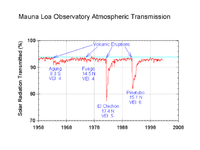
Photo from wikipedia
The hygroscopicity of marine aerosols may largely impact particle optical properties, cloud activation ability, and consequently the global climate system. This study highlights findings from real-time hygroscopicity and chemical composition… Click to show full abstract
The hygroscopicity of marine aerosols may largely impact particle optical properties, cloud activation ability, and consequently the global climate system. This study highlights findings from real-time hygroscopicity and chemical composition measurements in three open-ocean cruises over the Atlantic Ocean. Spatial variations in hygroscopicity (κ) for marine boundary layer particles (≤300 nm) were provided for the first time covering nearly 100° of the latitude over the Atlantic Ocean, ranging from 0.14 to 1.06. Externally mixed particles with remarkably low hygroscopicity (0.14-0.16) were observed near the equator influenced by biomass burning emissions transported from Africa. For marine aerosols, a positive linear correlation evidently existed between κ and wind speed within a range of 5-15 m/s even for nanometer particles. A closure study shows that the measured κ of 300 nm particles is well explained by the bulk chemical composition. A good negative correlation between measured κ and the organic mass fraction in PM1 for marine aerosols was found (slope = -2.26, R2 = 0.44), while a different linear relationship appeared for continental aerosols at several sites (slope = -0.47, R2 = 0.77). Accordingly, we provide a parameterization method to estimate bulk aerosol hygroscopicity both in continental and marine environments using particulate organic fractions.
Journal Title: Environmental science & technology
Year Published: 2022
Link to full text (if available)
Share on Social Media: Sign Up to like & get
recommendations!